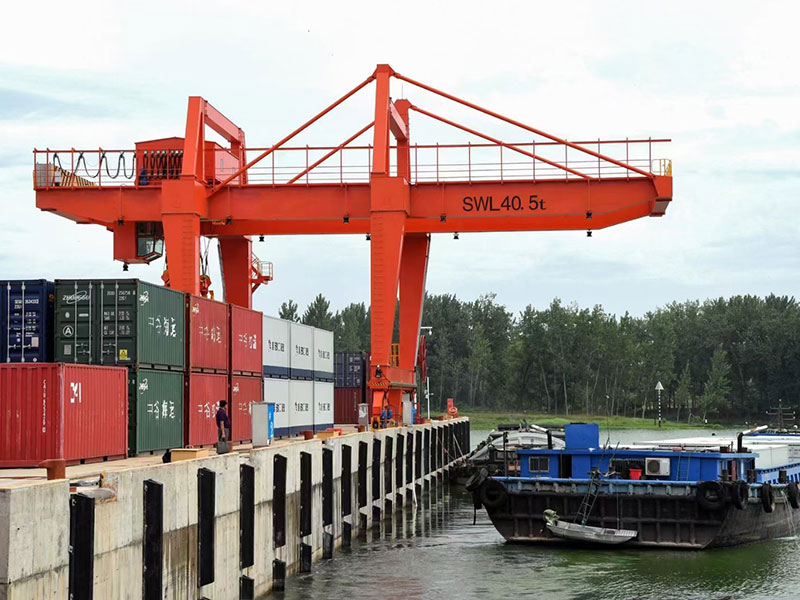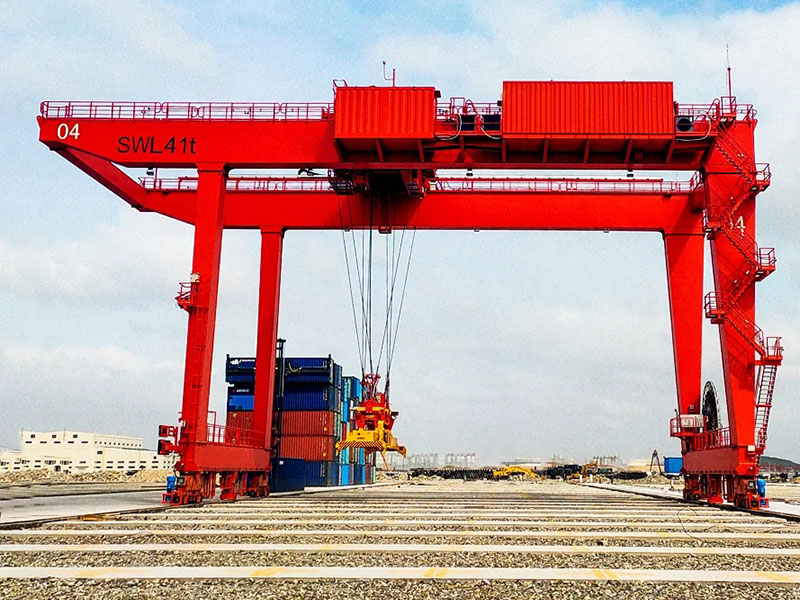Container handling gantry cranes, often referred to as container gantry cranes or simply gantry cranes, are vital giants of modern ports and container terminals. These colossal structures play a pivotal role in efficiently moving and stacking standardized shipping containers, facilitating the seamless flow of goods across the globe. In this article, we will delve into the working principles and functionalities of a container handling gantry crane.
1. Understanding the Container Handling Gantry Crane:
A container handling gantry crane is a type of crane specifically designed to lift, transport, and stack standard-sized shipping containers. These cranes are typically found in ports, intermodal yards, and container terminals, where they handle the loading and unloading of containers from ships, trucks, and trains. The primary purpose of a container handling gantry crane is to ensure the rapid and safe transfer of cargo between different modes of transportation.

2. Structure and Components:
Container handling gantry cranes are monumental structures, usually consisting of steel trusses or girders that form the main framework. The crane is mounted on rails or tracks to enable movement along the dockside or container yard. The essential components of a container gantry crane include:
a. Main Beam (Boom): The main beam, also known as the boom, is the horizontal beam that extends from one end of the crane to the other. It is responsible for carrying out the lifting and lowering of containers.
b. Trolley: The trolley is a movable platform that runs along the length of the main beam. It contains the hoisting mechanism, allowing it to move containers horizontally.
c. Spreader: The spreader is a critical attachment located at the end of the trolley. It is designed to grip the container securely during lifting and positioning.
d. Legs and Wheels: Container gantry cranes have tall supporting legs at each corner, with wheels or tracks at the base. This configuration allows the crane to move parallel to the dock for effective container handling.
e. Electrical System: Container gantry cranes are powered by electricity, which drives motors and hydraulic systems responsible for the crane’s movement and lifting operations.
3. Lifting Mechanism:
The lifting mechanism of a rail mounted container gantry crane is a combination of hoisting machinery and the spreader. The process of lifting containers begins with the spreader engaging the container at its corners or twist-lock positions. The spreader securely locks onto the container to prevent any accidental disengagement during the lifting process.
Once the spreader is securely attached, the hoisting machinery, which is located on the trolley, activates the lifting operation. Electric motors power the hoisting machinery, which operates a system of wire ropes and pulleys to raise or lower the container. This lifting mechanism can handle containers of various weights, typically ranging from 20 to 40 tons or more, depending on the crane’s capacity.

4. Horizontal Movement:
Container handling gantry cranes offer horizontal movement to efficiently transport containers along the dock or within the container yard. The horizontal movement is achieved through the trolley, which runs along the main beam. The trolley is equipped with wheels or motorized drives that enable smooth and precise horizontal positioning of the container.
5. Vertical Movement:
The vertical movement of the container gantry crane is accomplished by the extension or retraction of the main beam (boom). By varying the length of the main beam, the crane can lift containers to different heights. The vertical movement is crucial for stacking containers in multi-tiered storage areas or placing them on trucks and trains.
6. Operator Cab and Control Systems:
Container gantry cranes are operated by skilled crane operators who work from an elevated cab positioned on the trolley. The operator’s cab provides a clear view of the entire working area, enabling precise and safe container handling. Modern gantry cranes are equipped with advanced control systems that incorporate sensors, cameras, and computerized interfaces to enhance operational efficiency and safety.
7. Safety Features:
Safety is paramount in container handling gantry cranes, considering the massive loads they handle and the busy environments they operate in. These cranes are equipped with various safety features, including:
a. Load Monitoring: Sensors continuously monitor the weight of the lifted load, ensuring that it remains within the crane’s safe operating limits.
b. Collision Avoidance Systems: Cameras and sensors help prevent collisions between the gantry crane and nearby structures, containers, or personnel.
c. Emergency Stop Controls: Emergency stop buttons and controls are strategically located for rapid response to any potential hazardous situations.
d. Overload Protection: If the crane approaches or exceeds its weight capacity, overload protection mechanisms activate to prevent dangerous lifting conditions.
e. Limit Switches: Limit switches are installed to define the crane’s safe operating range, preventing it from moving beyond specified limits.
Conclusion:
Container handling gantry cranes are engineering marvels that revolutionized the cargo handling process, significantly reducing loading and unloading times at ports and container terminals worldwide. Their advanced lifting and transport capabilities, combined with robust safety features, enable the swift and efficient movement of shipping containers, contributing to the seamless global trade and supply chain logistics we experience today. Understanding the working principles of these powerful machines allows us to appreciate the complex orchestration involved in the movement of goods across vast distances and enhances our admiration for the ingenuity behind these colossal container handling gantry cranes.